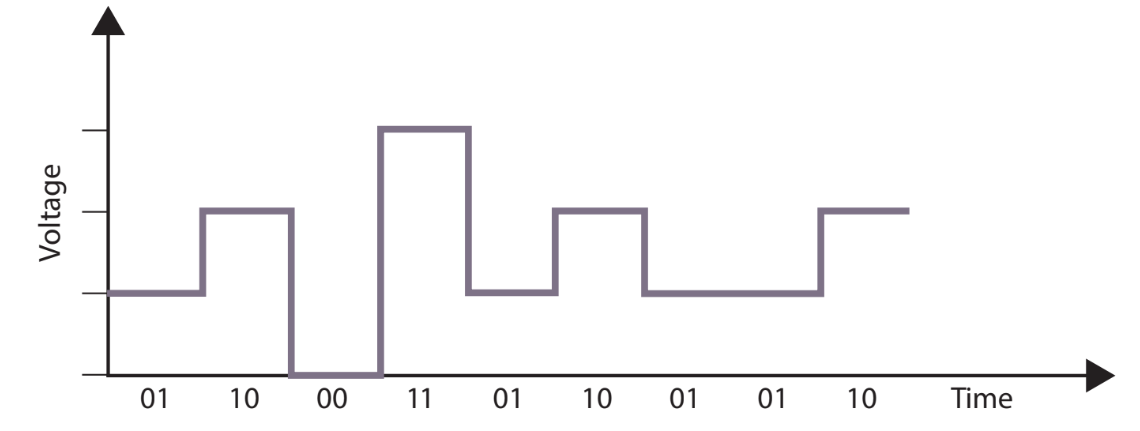Communication methods
Serial vs parallel data transmission
| Serial data transmission | Parallel data transmission |
|---|---|
| Bits sent via an interface one bit at a time over a single wire from source to destination | Several bits sent simultaneously over a number of parallel wires. |
| Very high transfer rates can be achieved (50Mbps - 100Gbps) as not affected by crosstalk [higher net data transfer rate] | Affected by crosstalk as signal frequency increases and over longer distances [lower net data transfer rate] |
| Reliable over very long distances | Only reliable over short distances - slightly different properties between each wire results in skew |
| Smaller and less complex connectors → less expensive | Larger, more complex connectors → more expensive |
Bit rate
- Bit rate: the speed at which data is transmitted serially, measured in bits per second
- ==Bit rate of channel = baud rate * number of bits per signal==
Baud rate
Baud rate: the rate at which the signal changes
The unit of Baud rate is Bd
==Baud rate of channel = bit rate / number of bits per signal==

For the above example:
- There are 4 different “voltage levels” on the vertical axis, representing 4 bit patterns (00, 01, 10, 11)
- This means that each signal can encode 2 bits (2 ^ 2 = 4 total bit patterns)
With 8 different voltage levels or frequencies, each signal can encode 3 bits.
- This is because 8 = 2^3
- A Baud rate of 1 MBd (megabaud) = 3 Mbps, or 3,000,000 bits per second
This can be generalised to:
No. of voltage levels = no. of bit patterns
No. of bit patterns or voltage levels = 2 ^ (how many bits each signal can encode)
Baseband
- Baseband: only two voltage levels are most commonly used, one to represent zero, and the other to represent one. Bit rate and baud rate are the same.
- Each signal can only encode 1 bit (2^1 = 2)
Bandwidth
- Bandwidth: the range of frequencies that a transmission medium can carry
- Direct relationship between bandwidth and bit rate
- Pipe carrying water: larger width of pipe → more water can be sent along it
Latency
- Latency: the time delay between the moment transmission of the first byte/packet of a communication starts and when it is received
- Primarily a function of how long it takes information to travel from source to destination
- When satellites are involved, the distance that information travels can be over 100,000km
- Think of the delay between a news anchor in the studio talking to a reporter on the ground far away. That most likely uses a satellite link, and it’s why there’s such a pause before they start speaking.
Parity
- Parity: a system of error-checking in which an extra bit is added to a byte of data before transmission to check if an error is likely to have occurred
- Can be either even or odd.
- Even parity: the total number of ‘1’ bits in every byte, including the parity bit itself, must be an even number
- Odd parity: the total number of ‘1’ bits in every byte, including the parity bit itself, must be an odd number
With both even and odd parity, if the total number of ‘1’s is not either even or odd (depending on the system used) at the receiving end, then an error has occurred in transmission and the data must be resent.
However, you cannot be certain that no errors have occurred as multiple bits could be affected, resulting in the correct total number of ‘1’s but different data.

Synchronous vs asynchronous transmission
| Synchronous transmission | Asynchronous transmission |
|---|---|
| Data transferred at regular intervals, timed by a clocking signal | Does not need to be a way of sharing the clock signal; bytes are sent one at a time, each character being preceded by a start bit and followed by a stop bit |
| Constant and reliable transmission for time-sensitive data (e.g. real-time voice/video) | Economical for relatively small amounts of data |
| Typically used by parallel communication (e.g. in the CPU) | Typically used by PCs |
The role of start and stop bits in asynchronous transmission
Start bit
Stop bit
Protocols
- Protocol: a set of rules relating to communication between devices
- To allow equipment from different manufacturers to be networked, protocols have been devised covering standards for:
- Physical connections
- Cabling
- Mode of transmission
- Speed
- Data format
- Error detection and correction
- Any pieces of equipment using the same communication protocol can be linked together
More on protocols